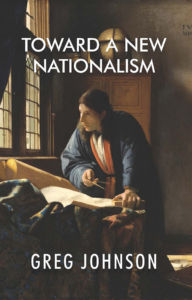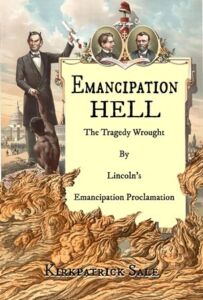The Proclamation from Hell
Kirkpatrick Sale
Emancipation Hell: The Tragedy Wrought by Lincoln’s Emancipation Proclamation
Columbia, S. C.: Shotwell Publishing, 2015
The emancipation of African slaves following the War Between the States is almost universally perceived as a great moral triumph, hence the enshrinement of Juneteenth as America’s newest federal holiday. While one will occasionally hear objections voiced to the way that then-President Abraham Lincoln conducted the war itself, the presumed righteousness of emancipation is rarely subjected to serious scrutiny.
The fact that slavery was abolished in all states following the war has been used as a post hoc justification for the Unionist cause, and many today believe that Lincoln waged the war for the express purpose of liberating the slaves, a notion utterly divorced from historical reality.[1] Lincoln’s reputation has benefited immensely from this misconception, and the man himself has been replaced in the public imagination with the legend of the “Great Emancipator.”
Emancipation Before the Proclamation
Slavery was seen by many prominent men of the founding generation as an unfortunate institution which the Republic would have been better off without. Take, for example, Thomas Jefferson, who included these lines in his original draft of the Declaration of Independence:
He [King George III] has waged cruel war against human nature itself, violating its most sacred rights of life & liberty in the persons of a distant people who never offended him, captivating & carrying them into slavery in another hemisphere, or to incur miserable death in their transportation thither.
Jefferson also accused Britain of inciting slave rebellions by promising freedom to those who would join with his loyalist forces against George Washington’s Continental Army. In so doing, wrote Jefferson, the King was “paying off former crimes committed against the liberties of one people, with crimes which he urges them to commit against the lives of another.”
This was ultimately left out of the Declaration, no doubt to appease some of the slaveholding contingent among the patriots, for slavery was never without its defenders. Yet, anti-slavery forces did achieve some notable victories in the antebellum years. The Northwest Ordinance of 1787 forbade slavery in what was then called the Northwest territory, consisting of land that would later become the states of Indiana, Illinois, Michigan, Ohio, and Wisconsin. The act of importing slaves from abroad was outlawed in 1807 by federal statute. At the state level, the “peculiar institution” was abolished in Pennsylvania (1780), New York (1827), New Jersey (1846), and Connecticut (1848). Additionally, in the early 1830s there was a serious effort to end the practice in Virginia.
Ethnonationalism and Emancipation
The Virginia proposals were motivated in large part by a desire for total racial separation, which was to be achieved through the process of “colonization” (i.e. resettling the emancipated slaves in Africa). The American Colonization Society (ACS), which could count among its members such men as Jefferson, James Madison, Henry Clay, and Francis Scott Key, was devoted to resettling freedmen in Liberia. The ACS made no secret of its desire to see blacks removed from the country, a goal shared by the influential abolitionist Hinton Rowan Helper.

You can buy Greg Johnson’s The White Nationalist Manifesto here
From an ethnonationalist perspective, African slavery was indefensible, but the appropriate thing to do would have been to give free blacks their own independent homeland, whether by securing territory for them in Africa or by setting aside some of the territory of the United States. Forcing the two races to live together was a terrible injustice to both. But since an alternative approach to emancipation that included racial separation and black independence would have made today’s multiracial America impossible (and diversity, as we are so often reminded, is supposed to be our greatest strength), to suggest that such an outcome might have been preferable to what we have now is to delve into the realm of heresy.
Like Thomas Jefferson, Abraham Lincoln was not a believer in integration, and would have much preferred that the freedmen be removed from America upon their emancipation. Still, the so-called “Great Emancipator” is now revered because he symbolizes a necessary step in the process that enabled America to become the multiracial state that it is today. Indeed, the true objects of contemporary Lincoln-worship are integration and multiracialism; Lincoln himself is a mere avatar of those ideas.
A Yankee Secessionist Takes on the Lincoln Myth
Those scholars who dare to question the Lincoln cult are likely to be bold, freethinking, and perhaps more than a little eccentric. Kirkpatrick Sale is just such a scholar. A native New Yorker with Leftist roots, Sale has previously contributed to such publications as The Nation and Mother Jones. He is also a radical environmentalist who is harshly critical of some forms of modern technology, to the extent that he once took a sledgehammer to a computer while giving a speech.[2] Back in 1985, Sale authored a book promoting the concept of bioregionalism, which supports the realignment of international borders so as to better reflect geographic features.[3] More recently he has been active in the Second Vermont Republic, an organization that promotes the idea of Vermont seceding from the Union, and another organization led by Sale co-sponsored a secessionist conference with the League of the South, an explicitly racialist Southern Nationalist group. In 2011, Sale was profiled in the American Conservative, which noted that
[h]is secessionist views stem from his rejection of the overarching “bigness” of political and social institutions. Sale’s landmark 1980 book Human Scale argues that virtually every institution — political, religious, social, economic — has grown too large and must be scaled down to better meet basic material and metaphysical needs. Needless to say, he shares conservatives’ opposition to big government, but he doesn’t think reforming it or scaling it down is possible. No, Kirk believes salvation from the modern state lies only in a full and final separation from it.[4]
Sale wrote a short volume in 2015 with the provocative title of Emancipation Hell: The Tragedy Wrought by Abraham Lincoln’s Emancipation Proclamation. This is a fascinating revisionist account of emancipation and its consequences. Though Sale is not himself a White Nationalist, many of the conclusions that he draws from his study of the war and the Reconstruction are entirely consistent with the ethnonationalist perspective.
Lincoln’s Emancipation Gamble
Sale begins his narrative with Lincoln’s decision to issue an executive order declaring all slaves in Confederate-held territory to be free. Lincoln decided to take this step in July of 1862, though he did not issue the order until that September, and it did not take effect until the following January. That the proclamation only applied to slaves in territory that the Union Army did not control was significant, for this meant that Lincoln did not actually free a single slave. He could, of course, have set free all of the enslaved people in the Union states of Delaware, Kentucky, Maryland, and Missouri, but this would not have made any progress toward his real goal. The Emancipation Proclamation, as Sale explains, “was not so much to create free people as to foster slave rebellions in the South (especially on plantations whose owners had gone to war) and to disrupt the food production on which the Confederate army depended.”
To give Lincoln his due, he did foresee the problems that would arise from setting 3.5 million blacks free, often penniless, into a society that did not want them. Thus, in December of 1862 he attempted to obtain Congressional support for a constitutional amendment that would establish a program of gradual rather than immediate emancipation, compensate slaveholders, and allocate funds to repatriate the freedmen. Sale compares this proposal favorably to the Emancipation Proclamation, deeming it “a far more realistic and solid appreciation of the complexities of true freedom.” He lays the blame for its failure at the feet of the more radical elements in Lincoln’s party “who in their ideological frenzy wanted a Proclamation whether or not it freed a single slave.”
Emancipation as Cover for Union War Crimes
In his discussion of the conduct of the Northern armies throughout the war, Sale describes the burning of cities such as Meridian, Mississippi, Atlanta, and Savannah in Georgia, and Barnwell and Columbia in South Carolina. He claims that the Proclamation, in addition to encouraging slave rebellions and the bloodshed that such insurrections would entail, also provided an excuse for Union troops to brutalize Southern civilians. His argument is that “when the new element to the war became the cause of eliminating slavery, a certain moral fervor was cast upon the troops, or a good many of them at least, that eventually added a kind of John Brown-like zealotry to the Union cause.”
I think Sale may be overstating his case here, however. As evidence that the Emancipation Proclamation was largely responsible for the adoption of “total war” tactics in 1863 by some Union commanders, Sale cites an exchange between Generals Hallek and Grant that took place that spring, wherein Hallek wrote that “the character of the war is very much changed.” Grant answered that “[r]ebellion has assumed the shape now that it can only terminate by the complete subjugation of the South . . .” It is not at all clear to me, however, that they are referring to Lincoln’s emancipation edict as the reason for this change in attitude. Conspicuously absent from Sale’s work is any quotation from a Union soldier that justifies atrocities committed on the grounds that they are fighting to “free the slaves.” This is not to say that such attitudes were not widespread, as Sale claims; only that he does not provide clear evidence that this was the case.
Another reason to doubt that it was Emancipation Proclamation and a hatred of slavery which motivated Union soldiers to rape and pillage the South from 1863 onward is the hostile reaction of these same soldiers at the time the Proclamation was announced. Sale confirms that the proclamation was “decidedly unpopular with the Union soldiers,” citing estimates that no fewer than 200,000 Union soldiers deserted in the winter of 1862-63, and he includes several quotes from Northern officers which show that the men they commanded were none too pleased by this sudden addition to Northern war aims.
Then there is the matter of the New York Draft riot, which Sale attributes to “men unwilling to be drafted to free black men who might then compete with them for laboring jobs.” All of this suggests that the Proclamation did more to harm morale among the fighting men of the North than it did to help it. Also, it should not be forgotten that there were four Northern slave states when the war began, and a fifth, West Virginia, was admitted to the Union after the issuance of the Emancipation Proclamation. It seems highly dubious that the “John Brown-like zealotry” described by Sale would have infected the Union soldiers of these states.
The so-called “Reconstruction”
Sale is scathing in his analysis of Reconstruction, and rightfully so. President Lincoln, despite all of his faults, was not willing to stoop so low in his treatment of the South as were the Radical Republicans. But Lincoln, brought down by an assassin’s bullet, was not there to temper the wrath of these vindictive legislators. That unenviable task fell to his Vice President, the Southern Unionist Andrew Johnson, whose presidency proved to be an utter failure. Lincoln, though, “had several ideas about the restoration of the Union that might have won the day.” As Sale writes:
At the core of his proposed Reconstruction was the idea of conciliation toward the South, easy paths to re-entry, a limited black franchise, and possible colonization of freedmen- all of which were espoused by Johnson once in office, but futilely, for he had no influence in Congress and no real personal following (except in his home state of Tennessee) to provide him with political clout.
Instead, it was the Radicals who got their way, and they inaugurated a program of suffrage for blacks, but disenfranchisement for much of Dixie’s white population. Sale tells the story of how a political alliance was formed between Northern “carpetbaggers” and newly-freed blacks, at the expense of Southern whites, in order to keep the Republican party in power. These occupation governments then proceeded to loot the states that they now ruled:
The fact that the governments were representative of only half or less of the population, were installed without any mandate, and had no constituencies to answer to (since they answered to the Union Army) meant that there were no barriers to open graft and corruption, which were practiced by both races with ingenuity and enthusiasm throughout their reign.
One blatant example of this took place in Mississippi, where taxes levied against white landowners were increased to the point that they were “fourteen times as high in 1874 as they were in 1869” by a black-dominated legislature. Whites were enraged across the South, and enmity between the races reached a fever pitch. Black militias were formed through organizations known as Union Leagues, which Sale calls “an arm of the Republican party.” This was made possible through the financial backing of Northern whites. White Southerners formed their own paramilitary groups, most notably the Ku Klux Klan. Sale approvingly quotes a report on Klan violence compiled by Northern Democrats in Congress, which deplored the Klan but also the oppressive Republican rule that precipitated it.
While those blacks fortunate enough to hold positions in the Reconstruction governments may have been living large at the expense of Southern whites, this was not the case for most of the freedmen. The Radical Republican program offered them no land of their own, but rather “a sure prescription for hostility between the races and penury for the large majority of free blacks after the war.” Slavery was finally abolished in all states by way of the ratification of the Thirteenth Amendment, but as Sale describes:
It did nothing, of course, to provide another social and economic role for the formerly enslaved, or to have any regard for the deprivation of the former slave owners, but its purpose was in fact more punitive than practical, as it enshrined the principles of the emancipation proclamation, limited as they were, in the Constitution.
The whole of the South was economically crippled by the war, and this hardship extended to former slaveholders who had once been responsible for housing, feeding, and clothing the slaves. The situation for most blacks in the South was therefore every bit as hellish as it was for whites, if not worse. For instance, the physical health of many blacks worsened after emancipation. Sale cites the work of James Downs, a Professor at Connecticut College, who estimates that “tens of thousands” of formerly enslaved blacks died of disease following emancipation. Sale observes that “[t]he failure of medical care was in essence the story with the rest of life for the freedmen” in that “no one had planned for their future after emancipation and no one in charge much cared about it, and as soon as their problems became intractable the north washed its hands of the whole morass.”
The Lessons of Emancipation

You can buy Greg Johnson’s Toward a New Nationalism here.
The post-emancipation South is one of countless examples of “diversity gone wrong.” When different peoples are forced to share the same territory, conflict and violence is to be expected. Yet, Reconstruction must surely rank as one of history’s most ill-conceived attempts at creating a harmonious multiracial society. The Republican tactic of using freed slaves as political pawns in the course of conducting a brutal military occupation was sure to end in disaster. Before the war, the non-slaveholding white population of the South saw black slaves not as fellow Southerners, but as a completely foreign people. Understandably, they were outraged when members of this alien race were placed in positions of authority over them. Just as understandably, many freedmen felt no love for the race of their former enslavers. Racial enmity between white Southerners and newly-freed blacks was exacerbated by the political violence and terrible poverty of the era. Suffice it to say, neither race made a favorable first impression on the other, a predictable outcome if ever there was one.
Sale is right to take Lincoln and the Radicals in Congress to task for their role in creating “emancipation hell,” but they do not deserve all of the blame. It must not be forgotten that the slaveholders were only too happy to benefit from the exploitation of unpaid labor, to the detriment of less prosperous whites. They must be assigned some responsibility for the disaster of Reconstruction. The same goes for the slave traders and the owners of the slave ships, as well as the African warlords who were willing to sell their own kinsmen to men of a foreign race. It is not uncommon for the upper classes of a society to sell out their own folk in order to make an extra buck. The elite planter class did not fulfill its duty to the rest of the white South. Racialist attorney and writer Sam Dickson made this very point in his essay “Race and the South”:
Had there existed a sufficient level of racial cohesion among whites, the emergence of a large, alien race in our midst would never have been tolerated. Part of this lack of racial cohesion may be found in class conflict within our own racial community, from antebellum times down to the present day. Slavery was of course to the material benefit of wealthy slave owners, but it was disadvantageous for middle class and working class whites, for the small, independent yeoman farmer.[5]
Unfortunately, this dereliction of noblesse oblige on the part of white elites did not end after the War Between the States. Dickson draws a parallel between the slave-owning class of the old South and the rootless capitalist class of today.
I see them in many respects as precursors of the corporate interests in our society that are colonizing our nation with Third World aliens: quite willing to burden America and its white posterity with rival, sullen, and hostile racial aliens so that these interests can obtain cheap labor at the expense of white Americans.
If whites are to overcome the perilous situation in which we now find ourselves, it will require a kind of racial solidarity that has been sorely lacking at the times when it was most needed. For that to occur, the myths on which the current regime justifies its power must be utterly discredited in the minds of our people, and replaced with a new worldview that affirms white racial consciousness and the necessity of racial preservation. When that day arrives, it will indeed be an occasion for rejoicing. Until then, we can take heart in knowing that there are scholars such as Sale who have the courage to provide readers with an honest assessment of our history. Emancipation Hell may be an unpleasant story, but it is one that white America needs to hear.
Notes
[1] If one examines the full text of the Emancipation Proclamation, they will see that individual Southern counties which were under Union occupation as of January 1, 1863 were exempted. These counties were to be “left precisely as if this proclamation were not issued.”
[2] Kevin Kelly, “Interview with the Luddite,” WIRED, June 1, 1995.
[3] Bioregionalism was praised by none other than Wilmot Robertson in his 1993 book The Ethnostate.
[4] Jack Hunter, “Radical Kirk,” The American Conservative, June 16, 2011.
[5] Sam Dickson, “Race and the South,” American Renaissance, 2006.




